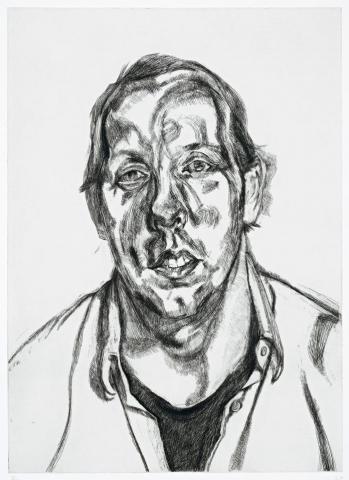DAVID DAWSON, 1998
Lucian Freud
etching
60.0 x 43.0 cm
signed with initials and numbered below image
proofed and printed by Marc Balakjian at Studio Prints, London
Matthew Marks Gallery, New York
Rex Irwin Art Dealer, Sydney (label attached verso)
Private collection, Queensland
This image has been exhibited widely throughout the world, most recently Lucian Freud: The Painter's Etchings, Museum of Modern Art, New York, 16 December 2007 – 10 March 2008, cat. 78
Hartley, C., The Etchings of Lucian Freud: A Catalogue raissoné 1946 – 1995, Marlborough Graphics and Ceribelli, London, 1995, cat. 56 (illus. another example)
Smee, S., Lucian Freud 1996 – 2005, Jonathan Cape, Random House, London, 2005, pl. 25 (illus. another example)
Feaver, W., Lucian Freud, Mondadori Electa S.p.A., Milan, 2005, p. 30 (illus. another example)
Figura, S., Lucian Freud: The Painter's Etchings, Museum of Modern Art, New York) New York, 2007, pp. 30 & 137, cat. 78, pl. 108 (illus. another example)
The grandson of eminent psychoanalyst Sigmund Freud, Lucian Freud is widely regarded as the most important figure in contemporary British painting. From his early works such as the celebrated Interior in Paddington, 1951, he rendered his subjects with a meticulous intensity, already displaying the harsh and penetrating observation that would inspire Kenneth Clark's famous description of him as the 'Ingres of Existentialism.' During the late fifties however, he substituted sable for hogs-hair brushes, and accordingly, this miniaturist style gave way to a broader, more robust approach; as Freud himself elucidates, 'I would wish my portraits to be of the people, not like them. Not having the look of the sitter, being them. As far as I am concerned, the paint is the person, I want it to work for me just as flesh does.'1
Today this voracious attitude to his subject is considered the defining feature of Freud's art. Stripping his subjects bare psychologically (and usually literally as well), he focuses upon the nakedness and vulnerability of human flesh, exposing its blotches, veins and wrinkles to a pitiless, devouring gaze. Dramas without incident or narrative, his portraits are distinctly disturbing in their carnality, thereby encapsulating Freud's belief that 'the task of the artist is to make the human being uncomfortable.'2 As reiterated by Robert Hughes in his highly acclaimed monograph on the artist, the reality pursued in Freud's paintings goes far beyond naturalism: it is both startling and disconcerting, producing some of the most powerful and harrowing images of the twentieth century.3
Executed with the painstaking scrutiny that Freud brings to all his subjects, the present etching David Dawson, 1998, nevertheless betrays a certain warmth in the friendly, relaxed disposition of the sitter. A figurative painter and photographer in his own right, Dawson was first introduced to Freud by the Professor of Painting at Royal College, at the beginning of the decade following the completion of his Masters Degree. Although initially employed as a studio assistant, Dawson suggests that today such a description does not really encapsulate his role: 'In the beginning I used to run around, get the paints in, make sure canvases were primed. Now I still do that but then you become more of a friend, more involved in the work. I'm always talking about what I think of his paintings as they're progressing. We have big discussions. We're quite good mates.'4 Significantly, in 2004 Dawson paid homage to Freud with an exhibition of photographs of the artist in his studio at the National Portrait Gallery, London; conversely, Freud too has immortalised his faithful friend in numerous works over the years, including most famously Sunny Morning - Eight Legs, 1997, which features Dawson sprawling naked with his whippet, Eli. Like the best of his intimate portraits of family and friends however, the present is also a portrayal of the artist himself, reflecting echoes and nuances of his own world; as Freud acknowledges 'Painters who use life will eventually reveal a facet of their lives. My work is purely autobiographical.'5
1. Freud cited in Lampert, C., Lucian Freud: Recent Work, Whitechapel Art Gallery, London, 1993, p. 6
2. Freud cited at http://richardnagy.com/artists/lucienfreud/
3. Hughes, R., Lucian Freud: Paintings, Thames and Hudson, London, 1997.
4. Dawson cited in 'Life with Lucian', The Guardian, 21 March 2004
5. Freud cited in an interview in Art Review, 2002: see http://www.constable.net
VERONICA ANGELATOS
